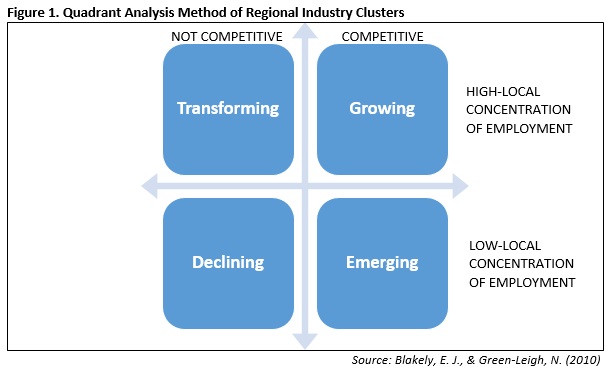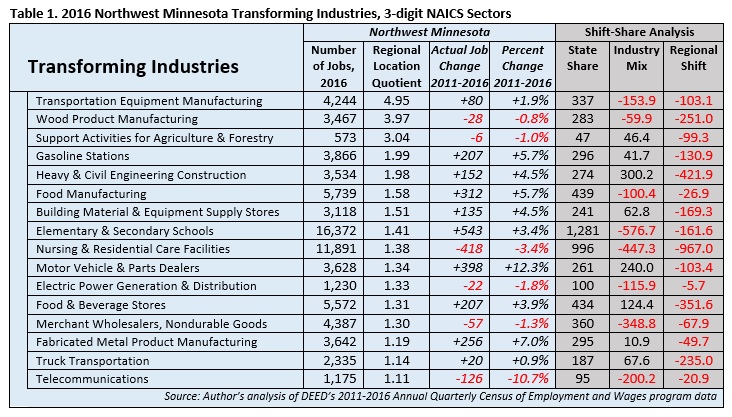 The presence of such industry powerhouses as Polaris, Arctic Cat and New Flyer make Northwest Minnesota a hub of transportation equipment manufacturing.
The presence of such industry powerhouses as Polaris, Arctic Cat and New Flyer make Northwest Minnesota a hub of transportation equipment manufacturing.
From wheat and potatoes to soybeans and sugar beets, the region is a major producer and processor of food staples and specialty agricultural products.
Want the freshest data delivered by email? Subscribe to our regional newsletters.
6/23/2017 12:04:56 PM
Chet Bodin
Determining industry clusters in a regional economy has been an important tool of planners and policymakers for decades. Regional industry clusters show communities the nuance of their economies, identify trends, and even suggest how a community might adapt to them. In particular, the Blakely and Green-Leigh quadrant method (Figure 1) clusters industry sectors by how well they withstand economic fluctuation. This method is unique in that it offers a matrix of sustainability, categorizing regional industries by their adaptation to economic change over time.
In this method, regional industries are grouped into four quadrants – transforming, growing, emerging and declining – based on both the local concentration of and change in employment from 2011 to 2016. The combined analysis of these two factors produces a unique approach to industry clusters, rather than those produced by employment concentration alone. For example, despite a high concentration of jobs in Northwest Minnesota and recent job growth, the Transportation Equipment Manufacturing industry has trailed the state in employment gains since 2011, landing in the ‘transforming’ quadrant.

Future Northwest Local Look blog posts will focus on these quadrants and the industries they identify in Northwest Minnesota. This month, the ‘transforming’ quadrant is highlighted. Transforming industries are highly concentrated in a region as measured by location quotient, but have not been locally competitive during the time period researched. ‘Locally competitive’ is determined by dissecting employment growth with shift-share analysis. In our analysis, regional employment changes are compared against those at the state level rather than the national level.
While transforming industries are often large sources of regional employment, their employment growth from 2011-2016 was often less than the state average, or they suffered job declines. Combined, these industries provided almost 75,000 regional jobs in 2016, accounting for just over one-third of total regional employment. Given the relative size of the transforming industries, their response to economic change is very important to the regional economy overall and, for whatever reasons, they haven’t been able to keep pace.
In Northwest Minnesota, there were 16 industry subsectors with location quotients greater than or equal to 1.10 that had no locally-driven employment gains from 2011 to 2016. Among them, Transportation Equipment Manufacturing had the highest location quotient of any three-digit NAICS sector in the region in 2016, at 4.95. This shows a regional concentration of jobs five times stronger than statewide, thanks in part to major local employers such as Arctic Cat and Polaris. However, employment growth from 2011 to 2016 was only 1.9 percent in the region – less than half the growth rate statewide – signaling that the industry has not been as competitive in Northwest Minnesota lately.
Interestingly, while most transforming industries actually experienced positive job growth in Northwest Minnesota from 2011 to 2016, they were outpaced by statewide shifts rather than local factors. For example, shift-share analysis indicates that regional Motor Vehicle and Parts Dealers expanded by 12.3 percent in Northwest Minnesota, but statewide job growth in the industry totaled 15.5 percent. Despite the region’s rapid growth, the regional competitive shift turned out to be negative. Ten of the 16 transforming industries saw the same phenomenon (Table 1).

There could be a variety of reasons that these industries are in a state of transformation. This invites more research into the factors mitigating local employment growth. Northwest Minnesota communities may seek to work with transforming-industry employers to better understand the challenges they face, and explore how they all might adapt to new economic norms and be more competitive in today’s economy.
Contact Chet Bodin at chet.bodin@state.mn.us.